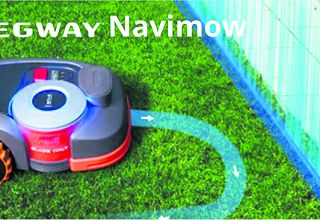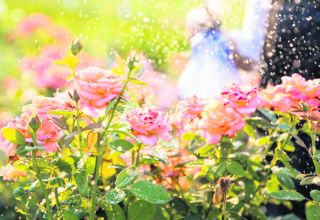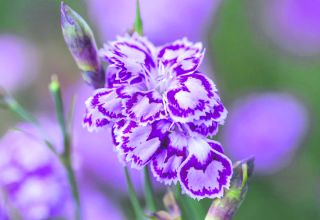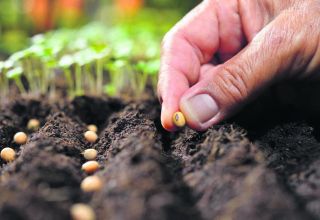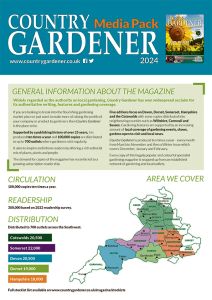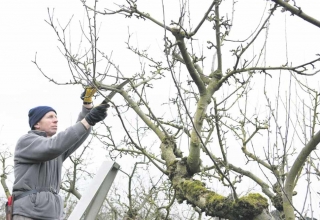
Autumn can be a time of hard work in the garden. The pace does change down another gear in the winter months but bright dry days cannot be wasted. Clear up the leaves from terraces and paths to give contrast to those that have been left in the beds. They will rot down among the perennials that are left standing. Spring bulbs should be in by now and those in pots covered to prevent the squirrels unearthing them, and the tender perennials that augment the hardy plants tucked away in the garage. And even in the dreariest days of November and December you can spot buds at the base of the hellebores and, in an act of defiance, the winter-flowering cherries provide colour. There is promise still despite what your bones might be telling you.
Prune apple and pear trees as a priority
You only get one chance a year to improve the quality and health of your apple and pear trees so make sure it is done properly. Pruning should be carried out when the tree is dormant – usually between November and early March, between leaf fall and bud burst.
To prune your fruit trees, firstly, always use sharp secateurs, loppers and a pruning saw, as blunt tools can lead to strains. Once all the leaves have dropped they will need some pruning to get them in shape for next year. (Wall trained varieties do not need pruning now.) Start by removing all diseased, damaged and dead branches.
Cut out very low branches that won’t get much light, crossing branches which rub and damage themselves and others and those that are growing into the centre of the tree. You are trying to create space at the centre and to open up the tree. Shorten very long stems by a third cutting to an outward facing bud. Remove any thin shoots coming from the trunk.
Make hardwood cuttings a must
Remember which way is up and which is down, and save the wood of vines to be made into hardwood cuttings. A pencil-sized piece of wood, cut below a bud at the bottom and above at the top, can be set into free-draining compost to half its length. Hardwood cuttings can also be taken from willows, poplars, Cornus alba and C stolonifera, and black mulberry, and make a cheap and reliable method of generating new plants. Willows are so easy that they can be plunged into the ground as whole branches, but the best results are always when the sap is still in the wood, so this side of Christmas is your goal.

Make some time for the birds
Natural food sources for birds are in short supply in the depths of winter. So help your garden birds by regularly putting out food for them.
It is better to feed them little and often, and always put out some fresh water too, especially when the temperatures are freezing.
Garden birds, in particular, benefit from feeding year round, but winter is a time to provide high fat treats to help keep them warm. Some birds need to recuperate 30 per cent of their body weight in order to survive the cold nights.
So, if you can, keep feeding them regularly so that birds will not waste vital energy visiting your garden when there’s no food.
Buy pots for bulbs indoors
For colour and scent over Christmas, you can’t beat pots of bulbs such as hyacinths or paper-white narcissus. Don’t worry if you didn’t get around to planting some in autumn, as you can buy pots of ready-grown bulbs now. To keep them at their best for as long as possible, put them in a well-lit spot in a cool room. The long leaves of narcissus look good when supported by a few twiggy stems from the garden. After the bulbs finish flowering, you can either throw them away or plant them in the garden.
Overwintering sweet peas
If you haven’t already sown your sweet peas, you can do this now under cover. Sown now, they’ll give you earlier flowers in greater numbers and a longer season. All legumes, these included, thrive with a long root run, so deep pots or rootrainers are ideal. Water the compost and then push a pair of seeds in to about an inch below the surface. Cover with newspaper to keep moisture and warmth in and light out. Some heat will speed up germination, but is not essential. They’ll germinate in about ten days but watch out for mice, they love them!

Plan ahead with your holly
If you have a berrying holly it’s a good idea to cut some boughs for Christmas now. How many of us have looked at a bush in November and looked forward to seeing the berries indoors for Christmas only to look two weeks later and see everything stripped by the birds. They will last perfectly well in a bucket of water in a sheltered corner.
Leave some architecture in the garden
If you are tidy-minded, it might go against the grain to leave the perennials standing, but in a few weeks’ time you will find that certain plants have made fine winter skeletons and can be left until February or March. Fennel and miscanthus, verbena and teasel make good hibernacula for beneficial insects and their seed keeps the birds going in the cold periods as well as providing winter interest.
Dispose of black spot leaves
The main job for your roses is to rake up and dispose of (in a bin or bonfire but NOT in the compost) all leaves with signs of black spot to prevent spreading the disease.
Start planning in the kitchen garden
Start thinking about all the veg you’d like to grow next season. Start making the must-have list of the things that you know taste better home grown and that you will look forward to eating. Try not to be unrealistic about what you can manage, or what you’ll actually get around to eating. Read our article on what veg to grow for more advice. You can then plan how and where you’re going to grow it all.
- Cover ground to keep out the wet.
- Sow Swiss chard under cover. You won’t regret it; once you get used to having this in your garden, you’ll wonder how you survived without it. You can use the stalks and the leaves, and it’s brilliant for risotto, gratins, stir-fries and soups.
- Place netting over brassicas to protect them from pigeons.
- Pick off yellowing leaves from the stems of Brussels sprouts.
- Sow leeks, onions, broad beans, hardy peas, spinach and carrots under.
- Use cloches or clear plastic to warm the soil for early sowings.
- Chit early seed potatoes just after Christmas.
Plus
- Check stored fruit and vegetables for signs of rot and dispose of any affected.
- Stake or earth up Brussels sprouts to prevent wind rock. Continue harvesting kale, parsnips, leeks and Brussels sprouts.
- Orchids such as phalaenopsis and poinsettias (Euphorbia pulcherrima) require a minimum temperature of 16-19°C (60-66°F), but do not position them close to radiators, open fires or draughts.
- Insulate outside plumbing. Store watering attachments indoors or make sure they are drained.
- Tidy up sheds and clean pots and trays making them ready for the next season.

